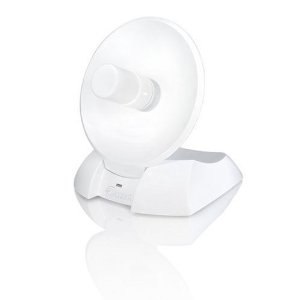Why the Super WiFi skeptics are wrong


It's the dog that hasn't barked. (Shown is a Hawking WiFi dish adapter, from Amazon.com.)
Ardent Bell proponents like Scott Cleland have been silent on the issue, preferring to focus on their fight against Google and net neutrality. The so-called "Progress and Freedom Foundation," which called WiFi itself "communism" a few years ago, has likewise kept quiet about the issue.
This has led some to claim the allocation is no big deal. No national allocation is being made. There will be a lot more spectrum in small cities than in big ones.
The critics and skeptics are missing an important point, namely whom tomorrow's order will be addressed to. While most spectrum orders are destined for carriers or their lobbyists, this order will be addressed to equipment manufacturers.
As with WiFi or any other unlicensed use, the Super WiFi order should be giving chip-makers like Broadcom and Intel an all-clear to begin making chip sets to certain specifications. In this case, this will include a function which tells a radio to use its GPS and check an Internet database before broadcasting.
That's a big deal. This kind of functionality has not been specified in hardware before. The fact that advocates say adding this is no big deal tells us a lot about where radio technology stands in 2010.
There is a second technical point to be made, one which is just as important.
One reason carriers are so crying over a looming spectrum shortage lies in how they design their networks. They are designed as wireless networks supporting mobile devices. Sounds simple and logical, but WiFi isn't designed that way. It's fixed.
WiFi is designed as an on-ramp to a wired network. Your WiFi router connects to your wired broadband. The coffee shop's signals are vacuumed into the larger Internet.
The purpose of Super WiFi is not to change this structure, but to enhance it and create competition for the wired component. It's just a longer on-ramp.
Instead of going into the nearest wire, Super WiFi makes it possible to find another wire, perhaps miles away, and funnel traffic to it. That wire might be competitive fiber, priced at a competitive rate, rather than copper offered at a monopoly rate. The resulting competition could drive down broadband prices for everyone.
It's true that in this case the Super WiFi signal could become a bottleneck. If 6 restaurants a half-mile from a phone switch decide to share backhaul using Super WiFi, their traffic could fill the air. And if someone else puts up a second or third or fourth Super WiFi set in the area, frequency contention could ensue.
Fortunately there are ways to engineer around that problem as well. A directional antenna. Aim the signal to a specific point and interference is minimized. Both sides of the frequency transaction get maximum use of the resource.
All the little tips and tricks that have evolved to maximize the capacity of WiFi over the last 10 years -- Pringle Cans, new encoding, maximum use of the wired infrastructure -- can be applied to Super WiFi by equipment manufacturers, and will be.
WiFi was an economic boon to wireless equipment companies, and Super WiFi can take the technology even further.